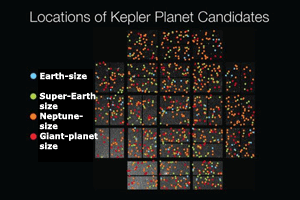The frame of the announcement were the results from Kepler’s first 4 months of observations, from May to September in 2009. At the time of launch, a couple hundred extra-solar planets had been detected, over the previous two decades, by ground-based observatories.
Early in 2010, NASA released some of the results from the initial observations: about 400 candidate worlds, mostly the big “hot Jupiter” planets (big balls of gas close to their stars, “easy” to detect) of the ilk that were being discovered monthly through ground based observations. Along with this announcement it was stated that a batch of Kepler data was being “embargoed” (or sequestered) to give Kepler scientists time to analyze it in more detail and make additional observations.
In December 2010 NASA announced the discovery of Kepler 10b, the first bonafide Earth-size rocky planet detection—albeit a red-hot lump of rock that orbits its star in less than a day.
Curtain lifts; drumroll please.... In Kepler’s first 4 months of staring at its target patch of sky in the constellation Cygnus, fully 1235 (with a capital T) candidate planets wink at us from the transit data—and after dusting away the “chaff” of hot-Jupiters and super-Jupiters, what’s left may be the very jewels Kepler set out to find.
Of the 1235 candidate planets (candidates because they still need to be confirmed—though Kepler scientists have said they believe 80-90% of them will turn out to be real planets, and not spurious blips in the data), 68 of them are approximately Earth-sized (some larger, some smaller, some spot on), and of those, 5 orbit their stars within the Habitable Zone: the right distance for sunlight to enable liquid water to exist.
Five worlds with the right proportions of material and heat to make the porridge “just right”! Awesome!
And this is not counting the “Avatar effect”: 49 other candidates found within habitable zones range in size from “super-Earths” all the way up to “super-Jupiters”—any of which could theoretically possess one or more moons of near-Earth stature, which would place those moons within habitable zones as well.
My head’s still reeling. What’s next? Will Kepler produce pictures of worlds with oceans, continents, and shorelines—or maybe 12-foot tall blue aliens? Is it time to start drafting a charter for a United Federation of Planets? Not yet....
Kepler was designed to do one thing: find Earth-sized worlds at water-friendly distances from their stars—and pending confirming follow-up observations, it may already have wildly outperformed NASA’s expectations on that front. Another two or so years of observations will be required for confirmations, but that’s only another Superbowl or two.
One thing is clear to me: From now on when I go out at night and look up at the sky, I won’t see stars; I’ll see planets. Lots of them….
37.8148 -122.178
 Kepler's patch of sky (one four hundredth of the total sky) filled
Kepler's patch of sky (one four hundredth of the total sky) filled